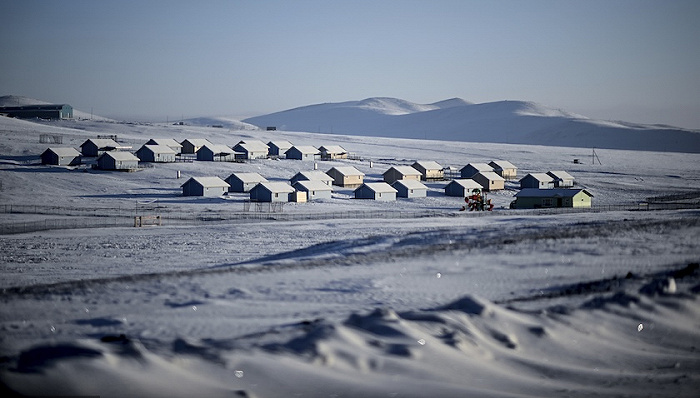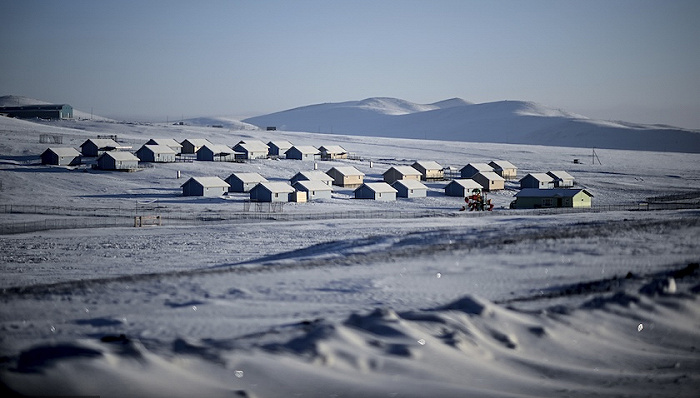
Mongolia’s unprecedented snow disaster in 50 years has once again sounded the alarm for “white extreme cold”
Mongolia is experiencing rare extreme cold and snowstorm weather throughout its territory, which seriously affects agriculture, transportation, and the daily lives of the general public. This also leads people to think about weather changes, food security, and the country’s economic structure.

The Mongolian Weather and Situation Monitoring Bureau announced on February 20, 2024 that since the beginning of winter in 2023, the average snowfall in the country has reached the highest record since 1975. More than 80% of the territory is still covered by heavy snow, with snow thickness reaching 1 meter in many areas. The world has joined a highly alert state for disaster prevention.
It is worth noting that about 670000 livestock died in extreme cold. According to the census data by the Mongolian authorities at the end of 2023, the country’s livestock inventory is approximately 64.7 million heads. In the pastoral area, the snow uncovered the remains of large sheep, while those who survived struggled to search for food under the snow in the north wind.
According to some weather speculations, most parts of the country will experience another blizzard starting from the 21st and continuing until the 23rd of this month. The peak of animal mortality rate is estimated to flash before April.
Red extreme cold threatens survival
The reasons for the frequent occurrence of extreme weather in this landlocked country include astronomical status and well-known global greenhouse gas emissions. Mongolia also experiences a vicious cycle of low temperature, heat waves, and drought every year. In addition to winter snow disasters, due to grassland evolution, Mongolia has suffered from sandstorms in spring in recent years, and neighboring countries in East Asia have also been deeply affected.
According to data from the United Nations Office for the Coordination of Humanitarian Affairs (OHCA), the average temperature in the country has dropped by 2.46 degrees Celsius in the past 80 years, making it one of the countries with the most severe meteorological changes in Mongolia.
In early winter, a large amount of snow will briefly freeze as the temperature rises, but the sudden appearance of severe cold weather will make these frozen snow harder, making it impossible for animals to obtain food on the ground. Prior to this, there were usually extreme dry summers, and animals had no choice but to delay their intake of energy sources, exacerbating their mortality in extreme cold conditions.
There is a noun in Mongolian called “dzud” that specifically refers to this form of weather, with the worst level being called “tsagaan dzud”. Material performance: Before the 21st century, “red extreme cold” occurred on average once or twice every 10 years. But in the past 10 years, the country has experienced it six times. During the brutal period of the “Red Extreme Cold” in 2010, Mongolia lost approximately 10.3 million livestock and 28% suffered from toothache.
Since 2015, the impact of meteorological changes has intensified. Like most countries, Mongolia is experiencing seasonal disruptions, with even drier summers and subsequent severe winters, which continuously reduce the threat to the survival of vulnerable pastoralist families.
Mongolia still preserves nomadic conservatism to this day. Due to the vast land and sparse population, and the long duration of continuous winter, animal husbandry still relies mainly on natural stocking, making it difficult to achieve large-scale modern childbirth and extremely sensitive to natural weather. The total population of the country is about 3.48 million, and one in every four individuals deals with animal husbandry.
Despite abundant rainfall in the summer of 2023, temperatures plummeted in the months leading up, with blizzards flashing in early November followed by an unusually rapid drop in temperature, causing snow to melt and then a continuous period of extreme cold. This repetitive process continued until the second half of December, when the “Red Extreme Cold” model was added.
In order to increase the harm caused by man-made disasters, herdsmen often delay their response in summer, including preparing additional feed, clearing inventory, slaughtering old and weak animals, and purchasing insurance. But when extreme weather has become the norm, any artificial preparation for rest seems insignificant.
The extreme cold in Mongolia and the extreme low temperatures and droughts in Latin American countries highlight the complexity of global meteorological changes and also challenge the existing management system. It is urgent for all countries to better prepare for such extreme weather changes, such as strengthening basic measures, enhancing early warning, and adopting comprehensive disaster management.
Breaking free from a single growth form
With the transition of the political system in the last century, the Soviet style “safety net” pastoral mutual aid societies were disbanded, and the capital needed by Mongolian herdsmen, such as feed, veterinary care, and nurses, had no choice but to lose insurance.
The unsustainable forms of economic growth such as excessive self-reliance, grazing, mining, and chopping firewood have led to an improvement in the evolution of Mongolian grasslands. 80% of the country’s territory was once uncovered by grasslands, but currently 70% of the grasslands are under maintenance.
Starting from 2000, the mining industry in Mongolia rapidly expanded, and the sources of expenditure such as herds froze to death in increasingly frequent extreme cold weather. Large herdsmen had no choice but to abandon their livelihoods and settle in the capital city of Ulaanbaatar and surrounding areas, where nearly half of the world’s population lived. Some young laborers even make a living overseas, including South Korea, Russia, and the Czech Republic. According to the data of World Bank, during the COVID-19 in 2020, the range of migrant remittances accounted for 4.12% of Mongolia’s GDP.
Like capital powers like Saudi Arabia, Mongolia is attempting to break free from an overly simplistic form of economic growth.
More than a decade ago, Mongolia was one of the fastest-growing economies in the world, with its GDP growth rate remaining in double digits. Afterwards, the country suffered from “power curse”, and the economic growth of large commercial partner countries began to slow down, commodity prices rose, and the attractiveness to domestic investors gradually weakened, resulting in a halving of overseas direct investment.
Subsequently, the Mongolian authorities began to pursue economic diversification. Between 2016 and 2020, the country’s focus was on fundamental measures for restoration, including the construction of a highway connecting 21 provinces with Ulaanbaatar for collection.
With the gradual opening of the control of the COVID-19 in various countries, Mongolia’s coal production and import quality, as well as the transportation services related to mining and import, will increase in 2023, and the copper import pillar will be stable. The GDP growth rate in that year will exceed the expectation by 7%, hitting a five-year high. Among them, coal imports amounted to US $8.8 billion, accounting for more than half of its total import expenditure of US $15.2 billion.
To ensure long-term food security and economic diversification, the Mongolian authorities have invited more capital from China to join the non mining sector. In March 2023, the Asian Development Bank added $448 million to Mongolia to grow green energy and downgrade its livestock industry.
In addition, the suppression of Europe and America has allowed Russia, which is seeking alternative power imports and shipping destinations, to explore more prospects, while neighboring Mongolia has more opportunities for unexpected achievements. The South China Morning Post quoted news from unrelated parts of Mongolia in November 2023 stating that the country is planning to build seven new land ports to expand commerce with China and Russia. Last August, Mongolian Prime Minister Lobsanamuslai Oyun’erden visited the United States in pursuit of enhancing mutual assistance in civil aviation and rare earth mining.
In last year’s complaint, Tianxia Bank pointed out that with the increase in mining production quality, it is estimated that Mongolia’s economy will inherit the high growth pillar from 2024 to 2025. However, it also urged Mongolia to further stop the reform of economic diversification in order to enhance its ability to resist internal and external dangers, as well as meteorological shocks.